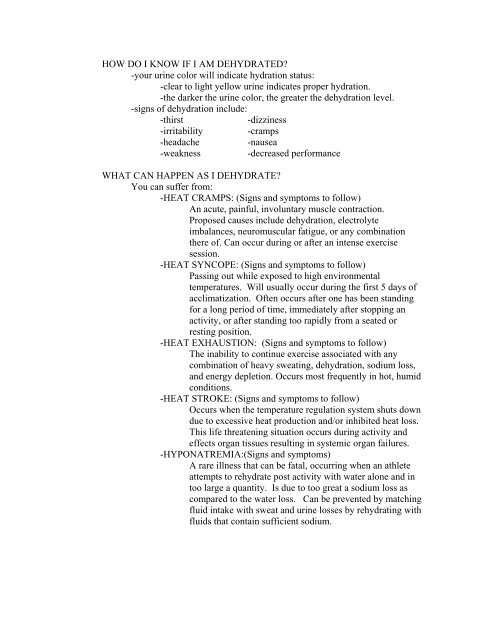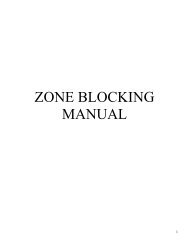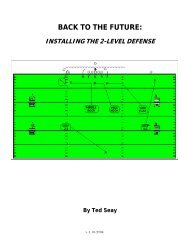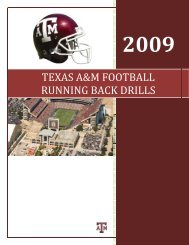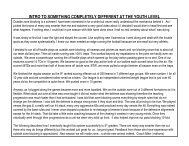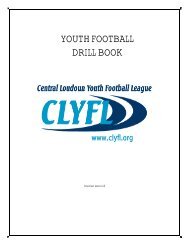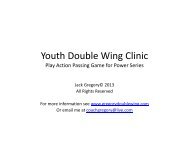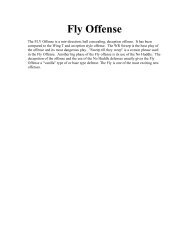HOW DO I KNOW IF I AM DEHYDRATED? - Gregory Double Wing
HOW DO I KNOW IF I AM DEHYDRATED? - Gregory Double Wing
HOW DO I KNOW IF I AM DEHYDRATED? - Gregory Double Wing
Create successful ePaper yourself
Turn your PDF publications into a flip-book with our unique Google optimized e-Paper software.
<strong>HOW</strong> <strong>DO</strong> I <strong>KNOW</strong> <strong>IF</strong> I <strong>AM</strong> <strong>DEHYDRATED</strong>?-your urine color will indicate hydration status:-clear to light yellow urine indicates proper hydration.-the darker the urine color, the greater the dehydration level.-signs of dehydration include:-thirst-dizziness-irritability -cramps-headache -nausea-weakness -decreased performanceWHAT CAN HAPPEN AS I DEHYDRATE?You can suffer from:-HEAT CR<strong>AM</strong>PS: (Signs and symptoms to follow)An acute, painful, involuntary muscle contraction.Proposed causes include dehydration, electrolyteimbalances, neuromuscular fatigue, or any combinationthere of. Can occur during or after an intense exercisesession.-HEAT SYNCOPE: (Signs and symptoms to follow)Passing out while exposed to high environmentaltemperatures. Will usually occur during the first 5 days ofacclimatization. Often occurs after one has been standingfor a long period of time, immediately after stopping anactivity, or after standing too rapidly from a seated orresting position.-HEAT EXHAUSTION: (Signs and symptoms to follow)The inability to continue exercise associated with anycombination of heavy sweating, dehydration, sodium loss,and energy depletion. Occurs most frequently in hot, humidconditions.-HEAT STROKE: (Signs and symptoms to follow)Occurs when the temperature regulation system shuts downdue to excessive heat production and/or inhibited heat loss.This life threatening situation occurs during activity andeffects organ tissues resulting in systemic organ failures.-HYPONATREMIA:(Signs and symptoms)A rare illness that can be fatal, occurring when an athleteattempts to rehydrate post activity with water alone and intoo large a quantity. Is due to too great a sodium loss ascompared to the water loss. Can be prevented by matchingfluid intake with sweat and urine losses by rehydrating withfluids that contain sufficient sodium.
SIGNS AND SYMPTOMS OF HEAT ILLNESSES TO WATCH FOR:-HEAT CR<strong>AM</strong>PS:-dehydrated-thirst-sweating-fatigue-multiple cramps affecting one muscle, than another, etc.-HEAT SYNCOPE:-dehydration -fatigue-tunnel vision -pale or sweaty skin-decreased pulse rate -dizziness-lightheadedness -fainting-HEAT EXHAUSTION:-headache-nausea-diarrhea-decreased urine output-persistent muscle cramps -profuse sweating-chills-cool, clammy skin-urge to defecate-weakness-hyperventilation-core body temp from 97 to 104 degrees F-HEAT STROKE:-core body tempo greater than 104 degrees F-central nervous system changes:-dizziness -drowsiness-irrational behavior -confusion-irritability -hysteria-aggressiveness -disorientation-staggering -seizures-hot and wet or dry skin-increased heart rate of 100 to 120 beats per minute-hyperventilation-vomiting-diarrhea-HYPONATREMIA:-nausea-vomiting-hands and feet swell -progressive headache-confusion -significant mental compromise-lethargy-seizures**Note: not every one will experience all of these signs and symptoms. Nor doyou have to experience cramping before you suffer from heat exhaustion or heatstroke.
<strong>HOW</strong> CAN I PREVENT DEHYDRATION?-acclimate to the heat over a period of 10 -14 days by beginning toexercise during the hot parts of the day for 10 -20 minutes and graduallyincrease your exercise time working up to 1 – 2 hours.-be sure to drink plenty of proper fluids during the acclimatization period.-drink fluids containing sodium to keep your urine clear to light yellow-if you sweat a lot, or heat conditions worsen, be sure to take in extra sodiumduring the day with your meals and/or or rehydration beverages containingsodium.-when exercising in the heat, cloths should be breathable and allow for propersweating and evaporation. Clothes that get wet and hold on to the sweat need tobe changed regularly.-alter intensity and frequency if exercising in the heat. Always make adjustmentsas the heat and/or humidity increase.-hydration breaks should be more frequent and longer as the heat and/or humidityincrease.<strong>HOW</strong> <strong>DO</strong> I <strong>KNOW</strong> <strong>IF</strong> I <strong>AM</strong> REPLACING FLUIDS PROPERLY?-always begin each exercise session well hydrated:-drink approximately 17 – 21 fluid ounces of water or a sports drink 2-3hours before exercising and 7-10 fluid ounces 10 -20 minutes beforeexercising.-fluid replacement should approximate sweat and urine loss:-this can be achieved by consuming 7-10 ounces every 10-20 minutes.-post exercise hydration should correct fluid loss:-should be completed within 2 hours post exercise-beverage should contain:-water to rehydrate-carbohydrates to replenish glycogen stores-electrolytes to speed rehydrationWHY ARE CARBOHYDCRATES IMPORTANT AND <strong>HOW</strong> MUCH SHOULD I HAVE?-carbohydrates replace the glycogen stored in muscles which provide the energy torecover and function for the next exercise session.-by consuming 17-21 ounces of a sports drink 2-3 hours before an event along withnormal dietary intake, should keep glycogen stores high enough for participation-if exercise levels will be intense that session/day, then consuming carbohydrates about30 minutes prior to the event/exercise session may also be beneficial.-carbohydrate levels in a sport drink should be about 6 % and no more than 8 %.-optimal carbohydrate replacement should be about 1 liter of a 6 % carbohydrate drinkper hour.-avoid the following beverage types during exercise; fruit juices, carbohydrate gels, soda,and some sports drinks that contain greater than 8 % carbohydrate concentrations,-post exercise, avoid consuming caffeine and carbonated beverages until rehydration iscomplete and then limit consumption to avoid setting the stage for dehydration for thenext exercise session.
<strong>HOW</strong> <strong>DO</strong>ES DEHYDRATION AFFECT MY PERFORMANCE?-Physiologically:-remember that water accounts for 73 % of lean body mass.-increases body core temperature during physical activity which may result in aninability to sweat properly, thus not allowing the body to get rid of theincreased heat generated through physical activity.-increased cardiovascular strain resulting in an increased heart rate, less bloodpumped from the heart, and increased resistance within the arteries and veins,making it more difficult for the blood to flow smoothly.-the cardiovascular changes are directly proportional to the level of dehydration.-heart rate increases by 3-5 beats per minute for every 1 % of body weightloss.-glycogen is used more quickly, elevated muscle temperatures, and increasedlactate level due to a poor blood flow-Performance:-muscle strength is affected when dehydration levels reach 5 % or greater-maximum aerobic performance decreases with as little as 3 % dehydration levels.-as dehydration levels increase, work capacity can decrease as much as 35 – 45 %.-significant performance deficits, while performing in the heat, have beenrecorded with a dehydration level as little as 2.5 % of body weightWHAT <strong>IF</strong> I <strong>AM</strong> PRONE TO CR<strong>AM</strong>PING OR SWEAT PROFUSLY?-be sure you add salt to your diet by adding a salty snack and/or adding a quarter to halfa teaspoon of salt to your food, especially during pre-season.-remember that if you increase your salt intake, you must also increase your water intake.-large doses of sodium (as found in salt pills) is not necessary if you make the necessarychanges in your daily food and beverage intake.-increasing sodium intake without increasing fluid intake, or increasing sodium intake ifyou do not suffer from cramps, may lead to dehydration and its effects simplybecause there is not enough fluid in your body to accommodate the increasedsodium levels.<strong>DO</strong> NOT FORGET………..-dehydration is very preventable.-a well balanced diet with plenty of fruits and vegetables will help keep you hydrated.-hydration starts days before the actual event/exercise session.-dehydration is cumulative. A loss of as little as 1% body weight compounded over afew days can lead to heat illness and decreased performance.-avoid over hydration.-optimal rehydration replaces fluids lost through sweating and urination within 2 hours ofstopping the activity.-when you begin feeling any of the signs and symptoms mentioned earlier, be sure to letyour coach and Athletic Trainer know. The effects of dehydration can worsenquickly.
The above information has been taken from:-The Gatorade Sports Science Institute; Tips for Safer Two-A-Days.-The Gatorade Sports Science Institute; Sodium: The Forgotten Nutrient-The National Athletic Trainers Association; National Athletic Trainers’ AssociationPosition Statement: Exertional Heat Illness--The National Athletic Trainers Association: National Athletic Trainer’s AssociationPosition Statement: Fluid Replacement for AthletesThese articles and other information regarding hydration and other topics, can be found at gssiweb.comand nata.org (search word hydration).


